
|   |

|   |
Branding Odisha, through Odissi - Shyamhari Chakra e-mail: shyamhari@yahoo.com Photos: Debojyoti Dhar January 27, 2017 In its bid to highlight its heritage tourism, Odisha Government’s department of tourism, known as Odisha Tourism, hosts three major dance and music festivals every winter – the Konark Dance Festival at Konark during December followed by the Mukteswar Dance Festival and Rajarani Music Festival during January in its capital city of Bhubaneswar. While Konark features all Indian classical dances, the just concluded Mukteswar dance festival, conceptualized 33 years ago, is exclusive with Odissi. It seeks to brand Odisha as the land of Odissi and promote cultural and heritage tourism worldwide. The dates of the three-day festival are fixed for every year - it commences on January 14 when Odisha celebrates the auspicious Makara-Sankranti. The sprawling green lawns of the 10th century Mukteswar temple, just beside the highway from the temple city of Bhubaneswar to the pilgrims’ paradise of Puri, wears a bridal look as the open-air auditorium is set up with the best of light and stage arrangements. The magnificent stone arch of the Mukteswar temple, that has been a popular symbol for Odisha, serves as the befitting backdrop for the festival. As the dusk descends, the evening comes alive with a choral offering by the best of Odisha’s musicians for Lord Mukteswar (the other name for Shiva) who is the presiding deity and after whom the festival has been named, followed by Odissi dance concerts offering an illusion for the frozen sculptures coming alive with poetry in motion. 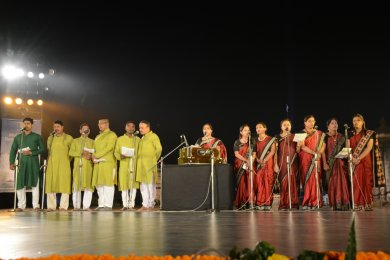 Choral singing 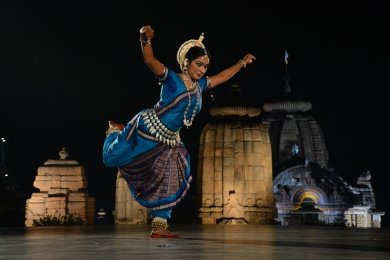 Sujata Mohapatra 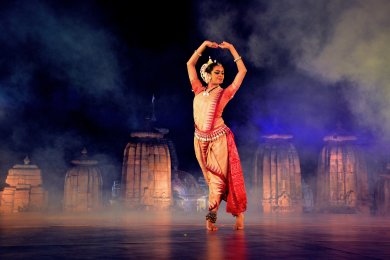 Shaswati Garai Ghosh 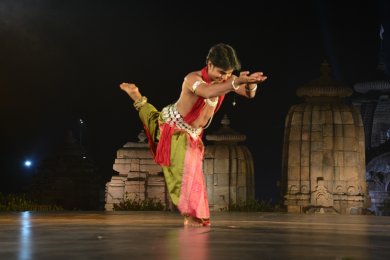 Pankaj Pradhan The three-day festival has a fixed format – it starts with the chorus and is followed by a solo, a duet and a group presentation. Following the format, the festival this year featured internationally acclaimed solo dancer Sujata Mohapatra and two young but gifted dancers – Shaswati Garai Ghosh from Kolkata and Pankaj Kumar Pradhan from Bhubaneswar. A celebrity, Sujata, who opened the festival and drew huge audience, staged her Guru and father-in-law, the legendary Kelucharan Mohapatra’s popular choreography Ramayana that included two excerpts - Sitaharana (abduction of Sita) and Jatayu Mokshya (salvation of Jatayu, the mythical bird who fought with Ravana to protect Sita and was killed). Young Pankaj, the only male soloist in the festival, premiered his Guru Aruna Mohanty’s thought-provoking choreography Belalasena, a character from the Mahabharata. The moving story is woven around the slain warrior, the son of Bhima and the snake-princess Belabali who claimed to end the 18-day war with just one shot from his arrow. His slain head was put on a pole in the battleground from where he watched the fury and the glory of the war and finally, as the lone witness to the entire war. Shaswati Garai-Ghosh emerged as the find of the festival this year with her peerless performance in her Guru Sharmila Biswas’ path-breaking choreography Murchhana: The eternal spirit of music. It was the moving story of mridanga, the indigenous percussion instrument of Odisha, drawn from the oral tradition of Odisha. Drawing three sequences from mythology, it portrayed how the body of the instrument has a soul that gives life to music that it creates. And we witnessed the body of the dancer – made for the sculpturesque Odissi – and her soul dancing together in unison with an effortless ease. Of the three duet performances, Pabitra Pradhan and Sridutta Bhol, the real life couple from the prestigious Odisha Dance Academy were the best. In the sensuality-soaked ashtapadi that ends with a touch of devotion in the shringar-bhakti tradition - Radhabadanabilokita - that portrayed the union of Krishna and Radha after a prolonged period of waiting, the couple did justice to their guru and choreographer Aruna Mohanty’s intense and vivid choreography. Though Arati Kar and Subhalaxmi Padhi pair from Bhubaneswar lacked any appeal, their two presentations gave glimpses of young choreographer Pravat Kumar Swain’s promising career as a choreographer. Presentation of the other pair, Sachikant Pradhan and Swagatika Sahoo, also from Bhubaneswar, was disappointing. There was neither any chemistry in the pair or any life in their dance; nor was there any brilliance in the choreographies by their mentor and Guru Naba Kishore Mishra. 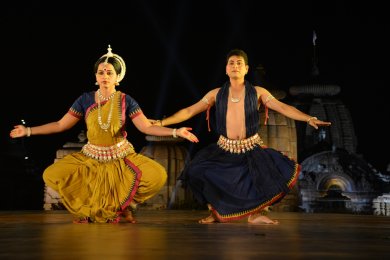 Sridutta Bhol and Pabitra Pradhan 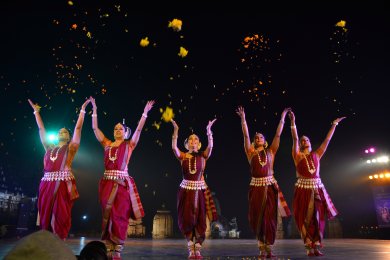 Sharmila Mukerjee and Sanjali troupe Bengaluru’s Sanjali Centre for Odissi led by its founder-director Sharmila Mukerjee won hearts with a neat group presentation. “Simple and beautiful” would be the apt assessment of their show that flowed like a gentle river complemented by the harmonious live orchestra by the best of Odissi musicians from Odisha. Sharmila’s venture with group presentation of her Guru Kelucharan Mohapatra’s popular solo composition Ahe Nilasaila, the prayer of the Muslim poet Salabega for Lord Jagannath, was well appreciated. The other two group presentations, New Delhi’s Natya Ballet Centre and Subas Swain’s Nrutyangana troupe from Odisha’s Dhenkanal town failed to make any mark. Billed as the ultimate dream destination for an Odissi dancer, the unique Mukteswar Odissi dance festival that is being watched by connoisseurs across the globe via live telecast and webcast deserves a more careful selection of artistes and troupes, if it aims at retaining its appeal. The past few years have witnessed the entry of poor and mediocre causing a concern for the festival’s future. A former journalist with Indian Express and The Hindu for nearly 20 years in Odisha, Shyamhari Chakra is currently an independent writer on dance matters. |